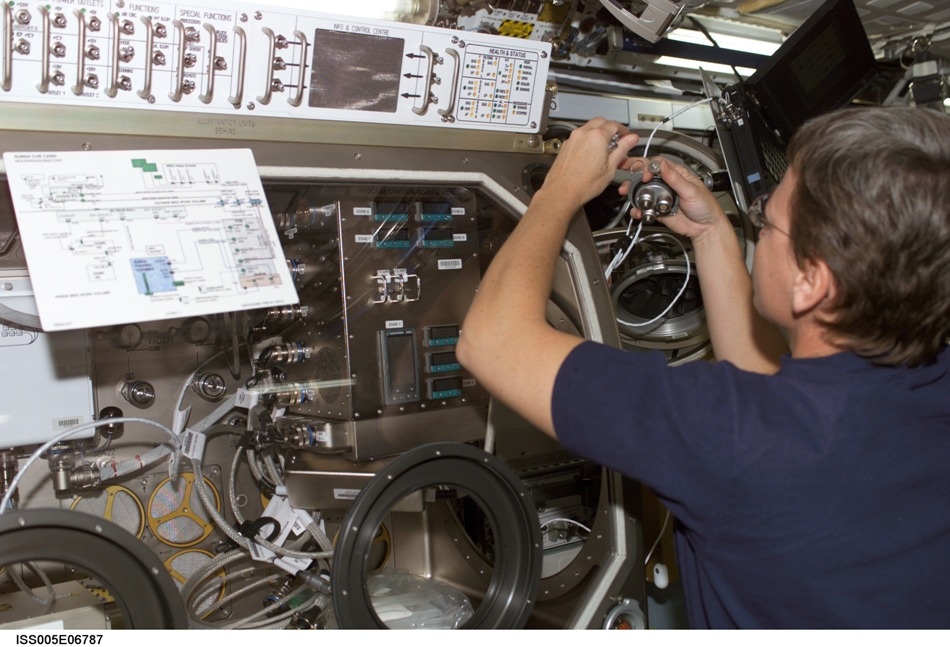Apr 21 2017
 The Solidification Using a Baffle in Sealed Ampoules (SUBSA) hardware being installed by NASA astronaut Peggy Whitson during Expedition 5. The SUBSA Furnace and Inserts investigation includes modernized data acquisition, high definition video and communication interfaces. Credits: NASA
The Solidification Using a Baffle in Sealed Ampoules (SUBSA) hardware being installed by NASA astronaut Peggy Whitson during Expedition 5. The SUBSA Furnace and Inserts investigation includes modernized data acquisition, high definition video and communication interfaces. Credits: NASA
One of the earliest investigations conducted aboard the International Space Station refers to the research into crystal growth in microgravity. This investigation continues even till today.
A suitable setting for developing crystals that are more perfect than their terrestrial-grown counterparts is provided by the unique microgravity environment of space. The potential benefits of growing the CYLC crystal in microgravity will be studied by the Crystal Growth of Cs2LiYCl6:Ce Scintillators in Microgravity (CLYC-Crystal Growth), a Center for the Advancement of Science in Space (CASIS)-sponsored investigation.
The CLYC crystal refers to a unique kind of multicomponent crystal system used to produce scintillator radiation detectors, a device that is sensitive to both neutrons and gamma rays.
It’s a spectroscopic crystal, which means, using this crystal, we can detect the presence and intensity of radiation, as well as identify which isotopes emit radiation by measuring the energy.
Dr. Alexei Churilov, Senior Scientist, Radiation Monitoring Devices Inc. (RMD)
The CLYC crystal is developed by a commercial product by RMD and is increasingly used to track and differentiate both harmless and harmful levels of radiation. The crystal is mainly used in homeland security as a method to detect smuggled nuclear materials. However, it can also be used for gas and oil exploration, scientific instruments, particle and space physics and medical imaging.
The Earth-grown crystals have however shown defects such as inclusions, grain boundaries and cracks, incidents which scientists like Churilov hope to eradicate by employing the space station’s microgravity environment as a growth habitat.
Research has proved that that many, though not all, crystals benefit from growth in microgravity. Even though the reasoning behind this phenomena it still being analyzed, research indeed points to the lack of buoyancy-induced convection, which impacts the transport of molecules in the crystal.
Our ultimate goal is to study the growth of CLYC in microgravity without the interference of convection and to improve the production of the crystal on Earth.
Dr. Alexei Churilov, Senior Scientist, Radiation Monitoring Devices Inc. (RMD)
The research for the CLYC Crystal Growth investigation will be performed within the Solidification Using a Baffle in Sealed Ampoules Furnaces and Inserts (SUBSA Furnaces and Inserts). SUBSA helps researchers improve the understanding of processes related to semiconductor crystal growth. It provides a gradient freeze furnace for materials science investigations. Originally, SUBSA was operated aboard the space station in 2002, the SUBSA hardware has been modernized and enhanced with high resolution video, data acquisition and communication interfaces.
During the investigation process, four crystal growth runs will be performed aboard the space station and then in the ground-based SUBSA furnaces, offering a view into the gravitational effect on their growth. After the investigation is complete, the space-grown crystals will then be compared against their counterparts on Earth, followed by testing for imperfections and effectiveness as radiation detectors.
Even though microgravity cannot be mimicked or reproduced on the ground, results obtained from the investigation will provide details about which crystal methods to use on Earth, how to enhance ampoule and furnace design and which crystal growth parameters to modify in order to obtain a more perfect crystallization process.
The total weight of the CLYC Crystal Growth investigation is small, with only a few kilograms together with packaging. However, the benefits can be huge as the data collected during the investigation will be instantly used in the production of CLYC crystals.
CASIS Orbital ATK CRS-7 Payload Overview
Jenny Howard
International Space Station Program Science Office
Johnson Space Center